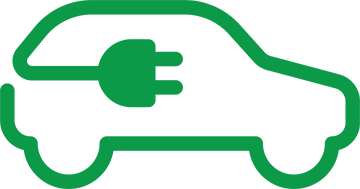
Worried about the effect of temperature, climate, and terrain on your EV's performance?
You're not alone. Discover how these factors can influence your electric car's charging rate, range, and overall efficiency.
Get insight into seasonal variations and how to adjust for cold weather and long highway trips.
Impact of Weather, Climate and Terrain on Electric Vehicle (EV) Charging
If you own or drive an EV, you need to consider seasonal variations and adjust to changing weather conditions to maximize your car's performance. Weather, climate, and challenging terrains (such as hills or highways) can significantly lower an electric car's charging rate and range.
In extreme weather conditions it’s important to plan a charging strategy that considers these impacts to optimize your EV's performance, including avoiding charging during peak power demand hours.
Extreme temperature conditions for an EV are defined as temperatures below 20F (or negative 6C) and above 95F (or >35C) and these extremes do affect your car’s range and rate of charge.
What happens in extreme conditions? If it’s very cold and below 20F or -6C, the battery's state of charge may decrease more quickly (how much energy you use to operate your car), which in turn affects the charging rate and range. When it’s very hot (consistently above 95F or 35C) the battery could heat up and reduce its efficiency.
Similarly, uphill driving or constant/consistent high-speed driving over long distances can quickly deplete an EV's battery. However, city driving with more frequent regen braking can actually help charge the battery.
How do you adjust for these seasonal variations? You can use features like battery preconditioning to warm up or cool down the battery before you charge or drive in extreme temperatures.
In the winter and fall, it's recommended to lower the car's range expectations and adjust the charging habits accordingly.
Pro tip: When you understand your EV's charging behavior and your driving pattern, you can optimize your EV's range and charging time.
Charging in Extreme Cold
In cold weather—and particularly during extreme conditions of below 20F or -6C)—the charging rate and range of your EV can significantly decrease. In short, your battery loses its ability to hold its charge as easily. These factors make it harder to plan trips and achieve expected results.
Here are a few things to consider, to help you maintain your EV's charging capacity in extreme cold weather:
Battery preconditioning: This is where you heat the battery before charging it, and improve its performance in cold weather. Many newer EV models offer battery preconditioning as a standard feature.
Adjust for Winter and Fall: In colder months, you can take steps like not letting the battery drain entirely before charging and keeping the car plugged in to make sure the battery stays above 50 percent state of charge.
Regenerative (regen) braking: EVs use regenerative braking to recover energy and recharge the battery while driving. Regen is less effective in colder weather, so you may need to adjust your driving style accordingly.
Plan ahead: Pre-planning a charging schedule can help minimize the impact of cold weather on an EV's range. Choose faster charging stations for highway drives or sudden falls in temperature.
With these tips, you can manage charging your vehicles better even in the toughest of weather conditions.
Charging in Hot Weather
Extreme hot weather (consistently above 35C or 95F) can significantly reduce the charging rate and range of your electric car. Battery performance can be affected, and the battery may degrade more quickly.

To mitigate this, park your car in a shaded area or garage, avoid charging during the hottest hours of the day and plan your trips to ensure easy charger location. Of course, consider climatic conditions, your drive style and the route you take and whether you can optimize the use of regenerative braking.
Pro tip: To avoid range anxiety, it's recommended to charge your EV with smaller more frequent top-ups (rather than wait for a deep discharge of your battery) and plan your trips accordingly. Carry an emergency charging kit and download an EV route planner to determine the best charging stations and routes for your travels.
Related article: 9 Tips for Driving and Charging and EV in Hot Weather
Charging on Hills and Highways
Hills can cause your EV to lose more energy than it regenerates, leading to shorter range, while city driving can also affect your EV's range due to frequent stops and starts.
Uphill terrain and highway driving can drain the battery faster, while downhill driving and driving in the city (where you tend to change speed or stop frequently) can actually help you conserve range and battery charge, by enabling regenerative braking.
Consistent high speeds on the highway can lower your EV’s range, cause the battery to drain faster due to increased aerodynamic drag and lack of regenerative braking.
Adjusting driving habits to account for seasonal variations can improve the efficiency and range of your EV.
To combat these challenges, it's important to make seasonal adjustments, such as battery preconditioning, adjusting for winter and fall, as well as pre-plan routes to include charging stations. Always be mindful of your driving patterns, such as avoiding aggressive acceleration.
Charging and City Driving
City driving has unique charging challenges for EVs, including stop-and-go traffic, limited access to charging stations, and seasonal variations that affect battery performance.
Regenerative (regen) braking: EVs utilize regen braking to recharge the battery while driving. City driving provides more opportunities for regen braking, improving range and charging rates.
Pro Tip: Pre-plan your city drives, explore regen braking, and consider seasonal adjustments to help maximize your EV's charging rate and range.
Adjusting for Seasonal Variations and Battery Preconditioning
To adjust for seasonal variations and extreme weather conditions, battery preconditioning is recommended, where the battery is heated or cooled before use to increase efficiency. Many new EV models have the capacity to precondition the battery. This normally happens if your car is plugged in.
Frequently Asked Questions
Q: How does extreme cold affect my electric car's charging rate and range?
A: In extreme cold temperatures, your electric car's charging rate and range can be affected. The cold can reduce the efficiency of your battery and cause it to drain faster than normal. It is recommended to use battery preconditioning to warm up the battery before charging and adjusting for the winter temperature.
Q: How does temperature affect my electric car's charging rate and range?
A: Temperature can greatly affect your electric car's charging rate and range. High temperatures can cause your battery to degrade faster, while low temperatures can reduce the efficiency of your battery and shorten your range. It is recommended to adjust your driving habits for the seasonal changes in temperature.
Q: How do hilly terrain and consistent high-speed driving affect my electric car's charging rate and range?
A: Hilly terrain and consistent high-speed driving can have an impact on your electric car's charging rate and range. Driving at high speeds or uphill can drain your battery faster, while driving downhill or slowing down can allow for regenerative braking to charge your battery. It is recommended to be mindful of conditions so you can adjust your driving habits for the terrain you will be driving on and the weather you drive through.
Q: How does city driving affect my electric car's charging rate and range?
A: City driving can have an impact on your electric car's charging rate and range. Quick accelerations can drain your battery faster, while stop-and-go driving slower speeds can allow for regenerative braking to charge your battery. It is recommended for the EV drivers to mindfully adjust driving style so you can make the most of the regenerative capacity of most EVs.
Q: How does highway driving affect my electric car's charging rate and range?
A: Highway driving can have an impact on your electric car's charging rate and range. Driving at consistent higher speeds can drain your battery faster, while slowing down or using regenerative braking can help to recharge the battery. If you are trying to conserve your car’s state of charge it is recommended to drive at a steady pace and avoid frequent sudden accelerations while driving on highways.
Q: How do seasonal variations affect my electric car's charging rate and range?
A: Seasonal variations such as changes in temperature and weather conditions can have an impact on your electric car's charging rate and range. It is recommended to use battery preconditioning and adjust your driving habits for the changing seasons to maintain optimal charging rates and range.
The Solution:
Lorem ipsum dolor sit amet, consectetur adipisicing elit, sed do eiusmod tempor incididunt ut labore et dolore magna aliqua. Ut enim ad minim veniam, quis nostrud exercitation ullamco laboris nisi ut aliquip ex ea commodo consequat.

